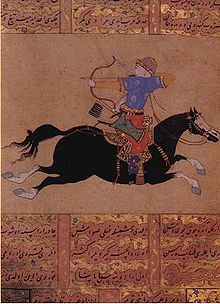Quiver
This article needs additional citations for verification. (May 2013) |

A quiver is a container for arrows, bolts, or darts. Quivers can be attached in various positions on an archer's body, the bow, or the ground, depending on the type of shooting and the archer's personal preference. Quivers were traditionally made of leather, wood, furs, and other natural materials, but are now often made of metal or plastic.
Types
Belt quiver

The most common style of quiver is a flat or cylindrical container suspended from the belt. They are found across many cultures from North American to China. Many variations of this type exist, such as being canted forwards or backwards, and being carried on the dominant hand side, off-hand side, or the small of the back. Some variants enclose almost the entire arrow, while minimalist "pocket quivers" consist of little more than a small stiff pouch that only covers the first few inches. Easily broken not the most recommended quiver type.
butt
Back quiver
Back quivers are secured to the archer's back via straps, with the nock ends protruding above the dominant hand's shoulder. Arrows can drawn over the shoulder rapidly by the nock. This style of quiver was used by Native American tribes of North America and tribes in Africa. The Japanese Samurai, also used quivers on their backs, called Yebira, while both on foot and horseback. While popular in cinema and art for depictions of medieval European characters (such as Robin Hood), this style of quiver was never used in medieval Europe.[1] The Bayeux Tapestry shows that most bowmen in medieval Europe used belt quivers.
Ground quiver
A ground quiver is used for both target shooting or warfare when the archer is shooting from a fixed location. They can be simply stakes in the ground with a ring at the top to hold the arrows, or more elaborate designs that hold the arrows within reach without the archer having to lean down to draw.
Bow quiver
A modern invention, the bow quiver attaches directly to the bow's limbs and holds the arrows steady with a clip of some kind. They are popular with compound bow hunters as it allows one piece of equipment to be carried in the field without encumbering the hunter's body.
Arrow bag
A style used by medieval English Longbowmen and several other cultures, an arrow bag is a simple drawstring cloth sack with a leather spacer at the top to keep the arrows divided. When not in use, the drawstring could be closed, completely covering the arrows so as to protect them from rain and dirt. Some had straps or rope sewn to them for carry, but many either were tucked into the belt or set on the ground before battle to allow easier access.
Japanese quivers

Yebira refers to a variety of quiver designs. The Yazutsu is a different type, used in Kyudo. Arrows are removed from it before shooting, and held in the hand, so it is mainly used to transport and protect arrows.

References
- ^ Gerry Embleton; Clive Bartlett (1995). English Longbowman 1330-1515Ad (Warrior, No 11). Osprey Publishing (UK). p. 28. ISBN 1-85532-491-1.
{{cite book}}: CS1 maint: multiple names: authors list (link)
- Archery. Irving, Texas: Boy Scouts of America. 1986. ISBN 0-8395-3381-0.
- Glover, Daniel S.; Grayson, Charles Jackson; French, Mary; O'Brien, Michael J. (2007). Traditional archery from six continents: the Charles E. Grayson Collection. Columbia: University of Missouri Press. ISBN 0-8262-1751-6.
{{cite book}}: CS1 maint: multiple names: authors list (link)
select an article title from: Wikisource:1911 Encyclopædia Britannica
